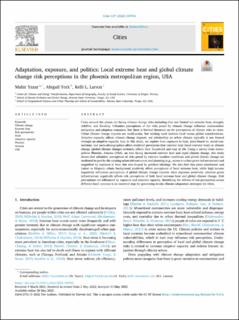| dc.contributor.author | Yazar, Mahir | |
| dc.contributor.author | York, Abigail | |
| dc.contributor.author | Larson, Kelli L. | |
| dc.date.accessioned | 2023-03-28T12:58:56Z | |
| dc.date.available | 2023-03-28T12:58:56Z | |
| dc.date.created | 2022-08-31T20:56:08Z | |
| dc.date.issued | 2022 | |
| dc.identifier.issn | 0264-2751 | |
| dc.identifier.uri | https://hdl.handle.net/11250/3060757 | |
| dc.description.abstract | Cities around the planet are facing climate change risks including (but not limited to) extreme heat, drought, wildfire, and flooding. Urbanites perceptions of the risks posed by climate change influence communities' mitigation and adaption responses, but there is limited literature on the perceptions of climate risks in cities. Urban climate change impacts are multi-scalar, but existing work isolates local versus global considerations. Adaptive capacity affects climate change impacts, yet scholarship on urban climate typically is not framed through an adaptive capacity lens. In this study, we explore how exposure to heat, place-based vs. social connections, and socio-demographics affect residents' perception that extreme heat (local extreme heat) or climate change (global climate change) seriously affects their household and way of life. Using a survey from metropolitan Phoenix, Arizona (USA), an area facing increased extreme heat and rapid climate change, this study shows that urbanites' perceptions of risks posed by extreme weather conditions and global climate change are mediated in part by the existing urban infrastructure and planning (e.g., access to urban green infrastructure) and magnified by exposure to heat, but also shaped by political ideology. We also find that place attachment and Latino or Hispanic ethnic background positively affect perceptions of local extreme heat, while high income negatively influences perceptions of global climate change impacts. Heat exposure positively, whereas green infrastructure negatively affects risk perceptions of both local extreme heat and global climate change. Risk perceptions are influenced by exposure and adaptive capacity. Identifying the drivers of risk perceptions across different local contexts is an essential step for generating in-situ climate adaptation strategies for cities. | en_US |
| dc.language.iso | eng | en_US |
| dc.publisher | Elsevier | en_US |
| dc.rights | Navngivelse 4.0 Internasjonal | * |
| dc.rights.uri | http://creativecommons.org/licenses/by/4.0/deed.no | * |
| dc.title | Adaptation, exposure, and politics: Local extreme heat and global climate change risk perceptions in the phoenix metropolitan region, USA | en_US |
| dc.type | Journal article | en_US |
| dc.type | Peer reviewed | en_US |
| dc.description.version | publishedVersion | en_US |
| dc.rights.holder | Copyright 2022 The Author(s) | en_US |
| dc.source.articlenumber | 103763 | en_US |
| cristin.ispublished | true | |
| cristin.fulltext | original | |
| cristin.qualitycode | 1 | |
| dc.identifier.doi | 10.1016/j.cities.2022.103763 | |
| dc.identifier.cristin | 2047735 | |
| dc.source.journal | Cities: The International Journal of Urban Policy and Planning | en_US |
| dc.identifier.citation | Cities: The International Journal of Urban Policy and Planning. 2022, 127, 103763. | en_US |
| dc.source.volume | 127 | en_US |

